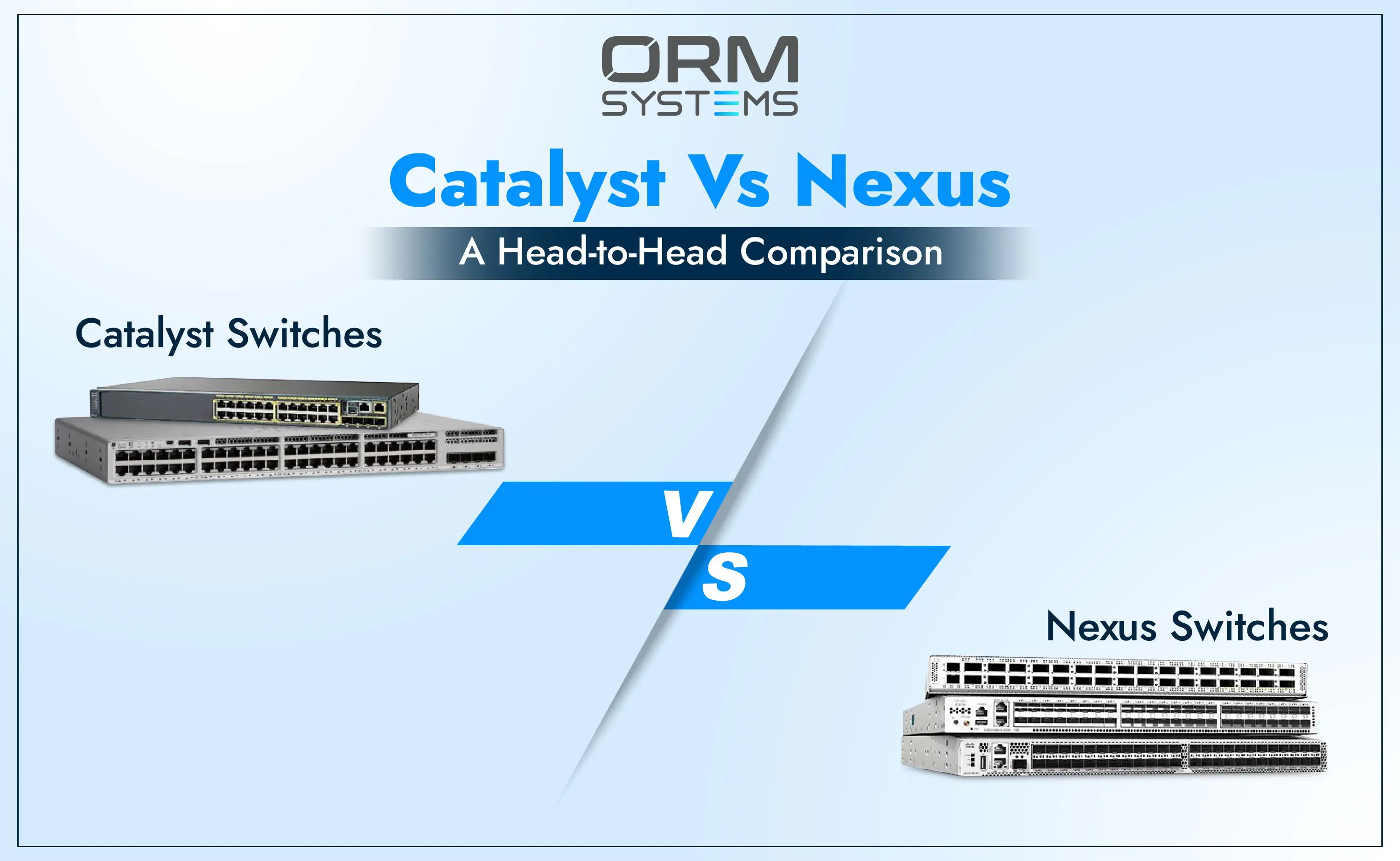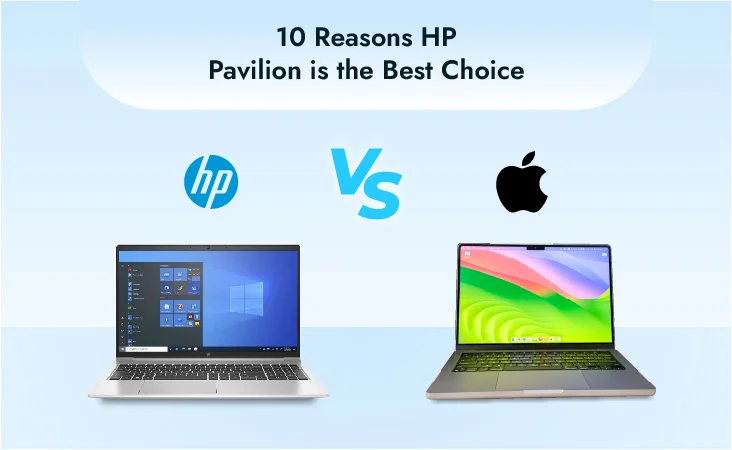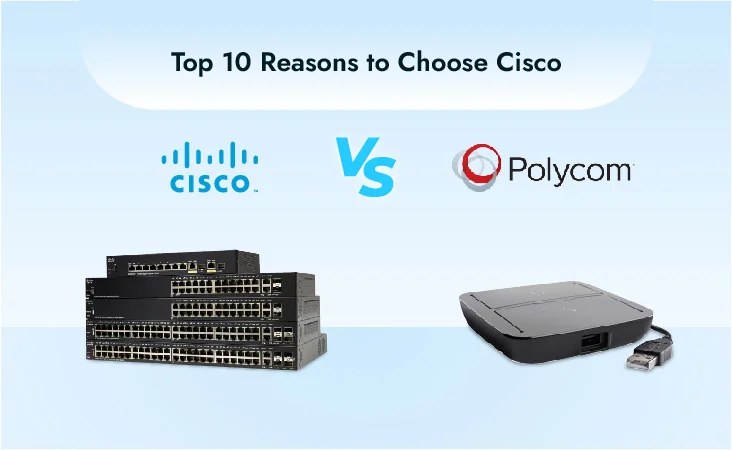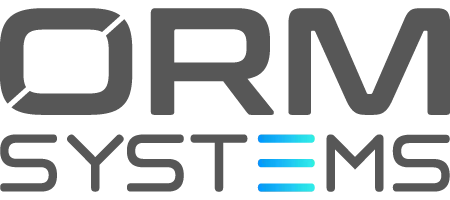PRODUCTS
 5
5In the realm of networking enterprises, an esteemed and renowned presence emerges in the form of Cisco, a distinguished seller of a vast array of network switches. These technological marvels serve as the key for adapting to the ever-shifting dynamics within your organization. While Cisco's extensive repertoire encompasses an assortment of switches, prominently featured are the Catalyst and Cisco Nexus switches, celebrated for their prowess in high-end networking.
In order to facilitate an erudite decision-making process concerning your networking requisites, we shall emphasize the question of Cisco Catalyst vs Nexus switch, while also diving into the key differences that demarcate these two distinct product lines. But first let’s talk about networking.
Cisco data center switches are the backbone of modern networks that connect devices smoothly in a company. These switches, which were created by Cisco, act as data traffic directors, ensuring that data travels more quickly and precisely within and between local networks. Cisco switches are effectively smart assistants that handle transfers between devices really well. They guarantee fast and dependable information transfer between devices by operating at a layer known as the data connection layer. Businesses love them because they're like the backbone of smooth information flow, creating a secure and dependable network.
Key Features of Cisco Catalyst Switches
Cisco Catalyst switches were introduced in 1994, and are known for their reliability, and widespread use in enterprise networks. Their ability to handle loops is unrivaled, Syslog information is simple to obtain, and excellent level-based filtering. Detailed SNMP traps can also help with early defect troubleshooting.
Catalyst switches offer features like high-speed connectivity, power over Ethernet, and detailed network security, making them an excellent choice for businesses of all sizes. Moreover, the fact that these switch units can handle both routing and switching is amazing.
ORM System recommends the following products from the extensive line-up of Cisco Catalyst switches: C9200-48P-E, C9200-48T-E, WS-C3850-12S-E, C9300-48UXM-E, and much more.
Catalyst switches are known for their robust performance and adaptability to various networking scenarios.
Cisco offers a wide selection of Catalyst switch series, ensuring that there is a suitable option for every business need.
Cisco Nexus Switches were first introduced in January 2008 and were made to do away with the need for computational networks and parallel storage by giving all servers access to all network and storage resources. On the other hand, the Cisco Nexus series demonstrates their unmatched capacity to handle massive volumes of data and provide reliable networking solutions, guaranteeing optimal performance and scalability for contemporary business needs. These switches are designed for use in high-performance data centers and virtualization environments. Outstanding scalability and performance are their hallmarks. Low latency, high bandwidth, and advanced virtualization support are among the features that make the Nexus series ideal for data-intensive applications. Its VXLAN support also allows it to function well in multi-tenant networks, which is perfect for cloud services. Carrying out their operations with Nexus switches is a challenging task, though.
The series is rather stable, and it allows you to upgrade individual Nexus switches while keeping the server up and running. The connection is very adaptable, so even if the on site is down, the network maintains quality. Its overall performance is outstanding, and its administration is simple.
ORM System recommends the following products from the extensive line-up of Cisco Nexus switches: Cisco Nexus 7700 series, N77-C7706, Nexus 7009 series, N7K-C7009-B2S2, Nexus 7000 F3-Series, N7K-F312FQ-25, and many more.
Cisco Nexus switches excel in terms of performance, offering low latency and high bandwidth for data-intensive applications.
The scalability of Cisco Nexus switches allows for the expansion of data center networks with ease.
The choice between Catalyst and Cisco Nexus switches ultimately depends on your organization's networking goals and infrastructure demands. To make an informed decision, assess your specific use cases and requirements. Below is the comparison between Catalyst switches and Nexus Switches:
|
Parameters of Comparison |
Cisco Catalyst Switches |
Cisco Nexus Switches |
|
Primary Use Case |
Access and Distribution Switches |
Data Center Switches |
|
Port Density |
Typically lower port density |
Higher port density |
|
Modular Options |
Limited modularity options |
Extensive modularity |
|
Forwarding Mode |
Store-and-Forward |
Cut-Through and FabricPath |
|
Layer 3 Routing |
Basic Layer 3 routing support |
Advanced Layer 3 features |
|
Convergence |
Faster convergence times |
Slower convergence times |
|
Virtualization |
Limited virtualization options |
Strong virtualization support |
|
Buffering |
Smaller buffers |
Larger buffers |
|
Latency |
Lower latency |
Lower latency |
|
Data Center Features |
Limited data center features |
Designed for data centers |
|
Unified Fabric |
Not designed for unified fabric |
Built for unified fabric |
When choosing between Cisco Catalyst 9200 and Cisco Nexus switches, consider your specific networking requirements. Catalyst switches are available in a wide range of series, each catering to different needs, while Nexus switches offer specialized solutions for data centers and virtualization.
Cisco Nexus switches are made with data center deployments in mind and frequently have a modular chassis design, whereas Catalyst switches work well in conventional rack-mounted network configurations.
Catalyst switches offer a wide range of advanced software features for network management, security, and quality of service, catering to diverse networking requirements.
When it comes to scalability and performance, Cisco Nexus switches outshine Catalyst switches, offering high-speed interconnects and support for large-scale data center networks.
Cisco Nexus switches are the recommended option for data centers, virtualization, and high-performance computing, while Catalyst switches are typically used in small to medium-sized businesses and traditional enterprise networks.
In the world of networking, choosing the right switch is vital to ensure optimal performance and connectivity. Cisco offers two distinct lines, Catalyst switches and Cisco Nexus switches, each tailored to different requirements. Cisco Catalyst switch runs IOS, whereas a Cisco Nexus switch uses NX-OS. Whereas Nexus switches only support LACP, Catalyst switches support both PAGP and LACP for creating Ether channels. So, based on your needs, you can select the best one.
If you want to buy Cisco switch, you are welcome to visit - https://www.ormsystems.com
Tags: Cisco ,Cisco Switch, Cisco Network, Cisco 9000 Series, Cisco Nexus , Cisco Catalyst
Related Topics:
Cisco Catalyst 9200 series switches Datasheet
Brand Switches Comparison: Cisco Catalyst vs Huwaei Switches
Cisco Catalyst 9300 vs 9200 switches
1. What are the primary differences between Catalyst and Cisco Nexus switches?
The primary differences between the Catalyst and Cisco Nexus switches lie in their intended use cases. Catalyst switches are designed for traditional enterprise networks, emphasizing reliability and versatility. In contrast, Cisco Nexus switches are designed for data centers, virtualization, and high-performance computing.
2. Are Cisco Catalyst switches suitable for large-scale data center deployments?
Catalyst Cisco switches are typically not the first choice for large-scale data center deployments. While they are reliable and versatile, they may lack the high-performance and scalability required in data center environments. Cisco Nexus switches, with their advanced features and scalability, are better suited for such scenarios.
3. How do I decide between Catalyst and Cisco Nexus switches for my business?
The decision between Catalyst and Cisco Nexus switches depends on your organization's specific networking requirements. Consider the size of your business, your budget, and the nature of your network.
4. Where can I purchase Cisco switches, and what should I consider when buying them?
You can purchase Cisco switches from various authorized Cisco partners, resellers, or directly from Cisco's official website. It's also essential to verify the authenticity of the seller to ensure you're getting genuine Cisco products with warranty and support.
Recent Posts

Managed Switch Vs Unmanaged Switch: Everything You Need to Know in 2024
10 September, 2024

qweqwdasd
10 September, 2024

Apple vs HP: 10 Reasons HP Pavilion is the Best Choice
26 June, 2024

Cisco vs Polycom: Top 10 Reasons to Choose Cisco
24 June, 2024

Elitebook vs Probook: 10 Reasons to Choose Probook for Daily Use
11 June, 2024
Most Used Tags

Developing performance-driven networks to boost the efficiency of your business

Thank you for your interest in ORM systems, our experts will connect with you shortly.



